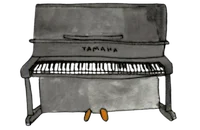Digital Pianos Vs Acoustic Pianos - Which are Better?

In a nutshell: A cheap digital piano is better than a cheap acoustic piano but an expensive acoustic piano is better than an expensive digital piano.
Please stay with me as we dig deeper into this question and see if the situation changes as your budget increases from £0, £100, £500, £1000, £3000, £5000 and above.
Later in this article, I will give a clear recommendation for how to achieve what I call, “Piano Bliss”, (owning a nice acoustic piano and optionally, a nice digital piano) without wasting a single penny in the process. Many people do end up with a perfect piano but they waste a lot of time, money and stress on the way.
Differences between digital pianos and acoustic pianos
Let’s quickly list the differences between digital & acoustic pianos:
Good things about digitals
- They don’t go out of tune
- They can be easily carried upstairs, downstairs, or away to University
- You can gig with them
- They can be easily connected to a laptop/tablet for recording or composing
- They can be placed in cold, hot, dry, or damp environments
- You can play with headphones to avoid disturbing others
Good things about acoustic pianos
- They are a genuine acoustic instrument
- They can help piano players “connect” with the music and the composer more directly.
- Most exams and recitals are on acoustic pianos so it is better to practise on an acoustic at home.
- The sound resonates in your fingers and body more directly
- They don’t require electricity
- They don’t require specific spare parts from the manufacturer if something breaks.
- They hold their value longer
- They bring a room to life
- No user manual required
Now, let’s get down to the nitty-gritty details and make some clear recommendations for you.
What’s wrong with cheap acoustic pianos?
To show you why a cheap or free acoustic piano is worse than a cheap digital piano let’s take apart a typical cheap piano and have a closer look at some the faults and see if a digital piano might be a better option.
Straight-strung

If you see a piano where all of the strings run parallel to each other then that means it is straight-strung. This is a big red flag. Straight-strung pianos typically have zero value and you should probably walk away. Any money you spend on it will be forever wasted. A cheap digital piano is better than a straight-strung acoustic piano.
Over-damped
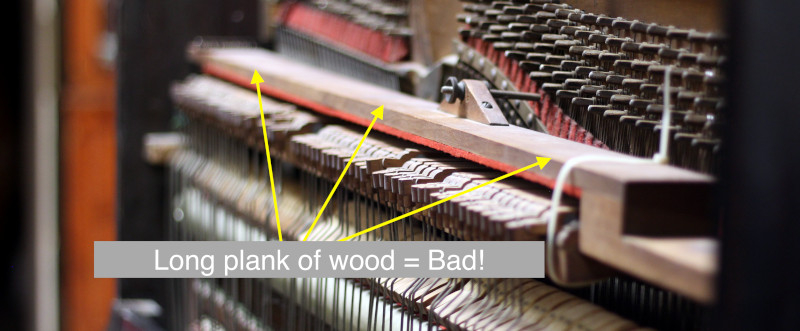
You must, must, must lift the top lid of any piano before buying it. If you see a piece of wood that runs all the way from one side of the piano to the other, hiding the hammers, then you should close the lid, close your wallet, and walk away. This type of “damping” (the system that mutes the strings when you stop playing the keys) is very old and inefficient and has been replaced by a better system on modern pianos. You need to walk away. A cheap digital piano is better than an over-damped acoustic piano.
Deep grooves in the hammers

Keep that top lid open and stand right over the piano. You might need to get right up on your tip-toes to see the front face of the hammers where they strike the strings. If you are looking at an old, unloved piano, chances are you will see 3 deep grooves on the front face of most of the hammers. This means that the piano has been used, possibly abused, and certainly not properly maintained for many years.
Whilst deep grooves in the hammers isn’t always a reason to walk away you should certainly take it as a warning sign and arrange for the piano to be professionally inspected before going any further. A cheap digital piano is better than most over-used acoustic pianos.
Stinky!
Many old, free, or cheap pianos really do stink and are full of decades of musty old dust. Some old pianos give me a wheezy chest and itchy eyelids. They can stink out an entire house just a few hours after being delivered. To test this, stand nice and close to the piano, then quickly open the top lid, stick your nose as deep into the piano as you can and take a deep sniff. Try it a few times and ask yourself if you want that smell to gradually waft its way around your entire house and wardrobes. Not for me! A cheap digital piano is better than a stinky old acoustic piano.
85 keys
Most modern pianos have 88 keys but many cheap old pianos have only 85 and whilst this issue alone shouldn’t make you walk away, you should take it as another warning sign. An 85-note piano has a very limited value (often £0) and you should never buy one without getting a 2nd opinion from a professional. A cheap digital piano is also unlikely to have 88 keys either so they both score equally bad on this issue.
Pass the sledge-hammer!
That covers most of the obvious flaws found in cheap acoustic pianos. Whenever I find a piano with 2 or 3 of these flaws, then I consider it to be my duty to put a sledge-hammer through the action to make sure that the piano never ends up in front of an ambitious young student. Such pianos are often advertised as a “lovely piano, just needs tuning,” and a young family might spend all of their budget buying it, getting it delivered, and having it tuned, only for it to be impossible to learn on.
We dropped a stinky, straight-strung, overdamped piano with 85 notes and deep grooves from a great height as part of our Christmas video. Watch the full video here

There are hundreds of pianos like this all over the UK and most of them end up on eBay, Facebook and Freecycle. You must do everything in your power to avoid taking one of them into your home.
Here is a video of my Dad “recycling” an old straight-strung upright piano that had reached the end of its musical life.
And here is a dreadful piano that was recently offered for free on Facebook. Notice that the seller is happy for you to take a broken piano but still describe the condition as “good”. That brand (Lindner) is famously dreadful and this advert backs up my advice that you should never consider taking a free piano without a full inspection.
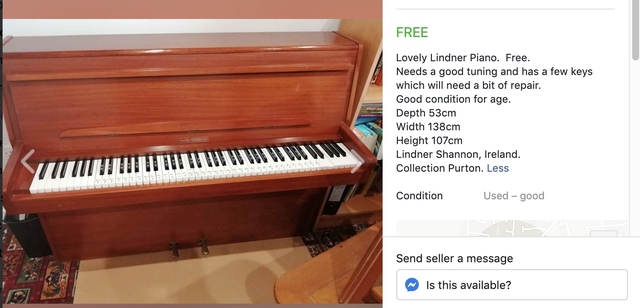
So that’s free pianos dealt with. Leave them alone. A cheap digital piano is almost always a better option than a cheap (or free) acoustic piano.
What to buy with a £100 Budget

Is £100 enough to get a nice acoustic piano? In short, no! Would you recommend a £100 car for a 17-year-old to take their driving lessons in? The car might need new tyres, a new battery, it might have no MOT, no power steering, and a rusty chassis. It’s a non-starter just like a £100 piano. You must walk away.
The good news is that £100 will buy you a perfectly usable electric keyboard to get you started. Look for something 2nd-hand made by Yamaha or Casio in working condition with at least 61 keys (try and find one with 76 notes if possible). Don’t worry about weighted keys or how many notes of polyphony it has, just enjoy getting started with your very own electric keyboard. As you progress you will certainly need something better so try to save up ready for a future upgrade.
The Best Cheap Digital Pianos
Here are some recommended 2nd-hand digital pianos for less than £100 which have at least 61 notes. In no particular order:
- Yamaha PSR-290 (see photo above), PSR-292 2nd-hand on eBay for £80-£100
- Try any of the Yamaha PSR series
- If you can push your budget try the Yamaha PSR-EW300 for around £150 2nd-hand or buy it new for around £240 from Amazon
To demonstrate that buying a cheap digital piano or electric keyboard is a great way to get started, here is a video that one of our Facebook followers sent to us showing her daughter playing and singing on a very basic keyboard.
[video here]
[Zoe comment here]
Before we talk about whether a £500 acoustic piano is better than a £500 digital piano, let me briefly talk about “negative value” pianos.
Negative Value Pianos
A piano has negative value if the cost of delivery, tuning and repair is higher than the value of the piano. If you buy a piano for £100 but spend £150 on delivery and a further £250 on tuning & repairs, then your piano now has a negative value of -£300. That is dead money that would have been better spent on a basic digital piano.
Is a £500 acoustic piano better than a £500 Digital Piano?
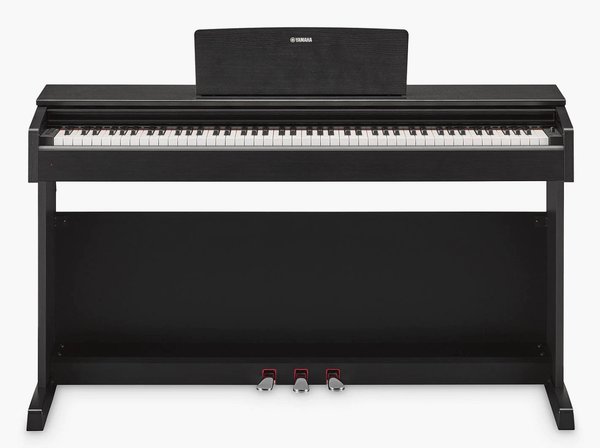
My advice for a £500 budget is the same as for a £100 budget. Do not get an acoustic piano. You will likely spend 50% of your budget on delivery, tuning, and repairs. If you have found a piano for less than £500 and you are convinced that the piano is at concert pitch with a wonderful action and tone then please don’t commit to the purchase until you’ve paid a professional piano technician to inspect the piano for you. Most people ignore that advice. Don’t be like most people!
You’d be much better spending your £500 on a good quality 2nd hand digital piano with 88 keys. Don’t buy a new digital piano for £500 as the quality will be less and it will quickly depreciate in value. Make sure you test the digital piano and all of its features before buying and you should end up with a good, basic instrument. Stick to the big 5 manufacturers (Yamaha, Kawai, Casio, Korg, and Roland) and you will find a full-sized keyboard with 88 weighted keys and a sturdy wooden stand with 3 pedals.
Some 2nd hand digital pianos to consider in this budget might include:
- Any of the Yamaha “Arius” digital piano series (see photo above): YDP-131, YDP-140, YDP-141, YDP-142, YDP-181, etc.
- If you prefer to buy new you could push your budget to £650 and buy a new Yamaha Arius YDP-144 from Amazon
- For a non-Yamaha option, search eBay for “Casio Celviano” or “Casio Privia” or buy a new one for £500 on Amazon
Acoustic vs Digital pianos with a budget of £1000-£3000
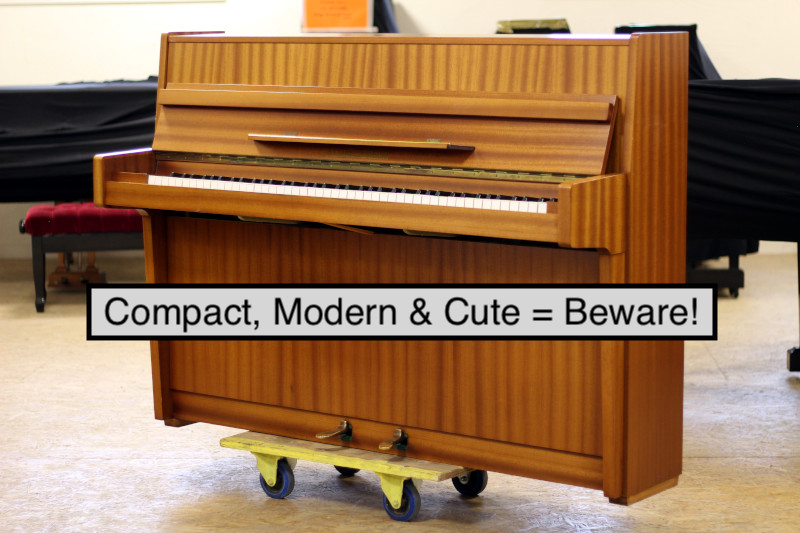
Congratulations! You’ve got a really great budget but is it enough to buy a great acoustic piano? Well, no, probably not, sorry! You are now in the budget where the worst mistakes are made. You are in the “Bermuda triangle” of the piano-buying ocean. All around you are ship-wrecks of acoustic pianos that promised so much but delivered nothing but disappointment and regret.
The majority of pianos ever made fall into this price range and most of them are rubbish. That means a whole lot of piano buyers are suffering a whole lot of regret. These pianos end up drifting around the 2nd hand market described as “in as new condition” and “only 10 years old” and “not played very often.” There’s a reason it hasn’t been played very often, it’s because it’s a dreadful piano that should never have been made, sold, or bought.
If they are so bad, how do manufacturers manage to sell 1000s of them? Easy! Make them look amazing! Too often, people buy pianos with their eyes instead of their ears and fingers. Buyers are drawn to small pianos that look great so manufacturers focus their efforts on making great-looking small pianos instead of making good musical instruments.
So here is your red flag! If you see a small piano that looks great and it costs £1000-£3000, it could be a hunk of junk and you MUST have it inspected by an independent technician before you decide whether to buy it or not.
In this budget, you will find pianos made over the past 10-40 years in places like Russia, the Czech Republic, Ireland, Korea, China, or Indonesia. Such pianos often have a modern design with a lovely mahogany veneer, they are usually very clean inside with little sign of use but are typically too small (around 110cm tall) to have a great sound and the action can feel a little on the “slow” side, and the sound can lack resonance, depth, warmth, and life! It looks like a piano, it sounds like a piano, but it is not likely to be a good quality musical instrument.
We can only offer £250-£800 in part-exchange for these pianos to customers who visit our showroom looking to upgrade after realising their mistake. So be careful, you can waste a lot of time and money in the £1000-£3000 budget.
At the top end of this budget, it is certainly possible to get a good quality piano but your only chance of achieving this is to hire a professional to help you. I would set aside £200 of your budget to pay a qualified piano technician to inspect 3 or 4 pianos with you. You mustn’t rush, you must be patient, and you must be prepared to walk away from any piano that isn’t perfect.
Best Acoustic Pianos for £1000-£3000
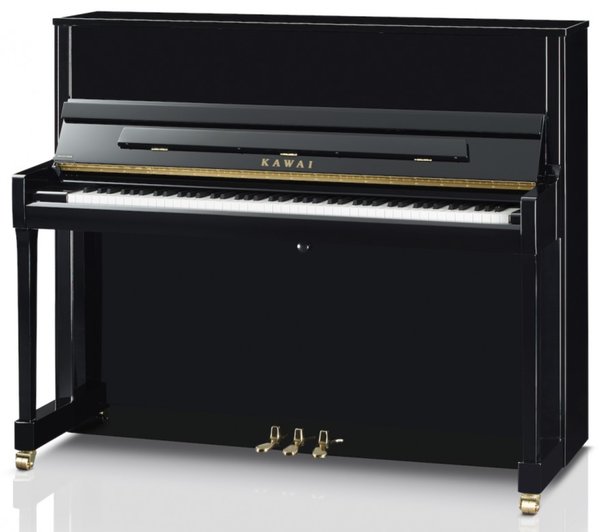
At the top end of this budget, you might look towards intermediate level pianos such as the Yamaha P121 or some of the Japanese-made Kawai uprights like the K-300 (see photo above) or perhaps some British-made Kemble uprights being sold by private sellers. Try to stick to pianos above 120cm tall and avoid pianos made in China, Indonesia, Korea, Russia, Czech Republic, or Ireland. The most important thing is to have the soundboard, wrestplank, action, and strings inspected by your technician. Don’t skip that step (most people do).
Or buy a high-end digital piano for the same money

£1000-£3000 will get you a very high-end digital piano with properly weighted keys or even an integrated hammer action to mimic the feel of an acoustic piano. You should still stick to buying 2nd hand so that your budget will take you towards much higher-end models compared with buying new. A digital piano of this quality should last a generation, you can easily move it around the home or upstairs, to a new house, or it can be sent to university if you have children approaching that age. It can be gigged with, it’s ideal for using with Garageband, ProTools, LogicPro or Sibelius, etc.
Here are some digital piano models to consider. There are many others, just is just the tip of the iceberg.
- Yamaha CP1 or CP4 2nd-hand approx £1000-£1500
- Yamaha NU1 or NU1x Avangrand 2nd-hand for around £2000-£3000 (see photo above)
- Roland V Piano 2nd-hand for around £2000-£2500
£1000-£3000 Conclusion: Digital or Acoustic?
In this price range, it is very easy to buy a terrible acoustic piano but very difficult to buy a bad digital piano. The majority of acoustic pianos at this level are underwhelming but the majority of digital pianos will do a great job. In this price range, I would still strongly advise you to buy a digital piano as you have far less chance of making an expensive mistake.
£3000-£5000 (the tipping point)

We now arrive at the tipping point where my advice begins to change. If you have £3000-£5000 to spend, then I think you have a fabulous opportunity to bring a top-quality acoustic piano into your home that will last a lifetime.
The mid-range of this budget will give you access to the wonderful 121cm tall Yamaha U1 along with other similar Japanese models made by Kawai such as their K5 or K500.
The upper end of this budget takes you towards the Yamaha U3 and the wonderful, upgraded, hand-finished versions of the U3, such as the UX, the UX-3, the U30A, U30BL, and similar models. If you end up with one of these models in your home you’ll never look back.
Here is a lovely rendition of Stevie Wonder’s “You are the Sunshine of my Life” played on a Yamaha U3.
And here is Chris Price (concert pianist and piano technician) playing on a Yamaha U300 that we had in stock recently
Important side note: £3000-£5000 will only buy a super quality acoustic piano if you stick to the 2nd-hand / reconditioned market. If you are buying new you will need to double your budget to enjoy the same quality.
Recommended acoustic pianos for £3000-£5000
- Reconditioned Yamaha U3 (131cm tall) or improved models such as Yamaha UX3, U30BL, U30A
- Reconditioned Yamaha U1 (121cm tall) or improved models such as Yamaha UX-1 or U10BL
- Reconditioned Kawai K3 / K300 (122cm tall)
- 2nd-hand but nice and young Yamaha P121 (121cm tall)
I need to stress again the importance of arranging for an independent inspection of any acoustic piano that you are considering buying. There can be hidden issues that need an expert eye to identify, most notably loose tuning pins, wrest-plank problems, or issues with the soundboard. This applies to private sellers and also piano shops. Most piano shops will be happy for you to arrange for your own technician to inspect any of their pianos and it really is money well spent. You must not rely on any private seller or piano shop flagging up hidden issues within the piano.
Your Route to Piano Bliss
I want to include an ideal route for you to follow so that you can end up with a winning combination of digital and acoustic pianos in your home without wasting any money so I’ve plotted out 4 different routes to piano bliss depending on your budget.
Route 1 – Starting budget £0
1. Do nothing. Under no circumstances should you acquire a free acoustic piano
2. Save up £100 and buy a 2nd-hand electric keyboard with at least 61 notes
3. Then save up for a £500 2nd-hand digital piano with 88 keys.
4. Keep this digital long-term whilst you save up for an acoustic piano worth at least £3000 that you buy with the help of a piano technician.
5. Enjoy your 2 nice pianos.
Route 2 – Starting budget £500
1. Spend £500 on a 2nd-hand digital piano with 88 weighted keys
2. Do not spend £500 on an acoustic piano
3. Enjoy your digital piano until you can save up at least £3000 for a Yamaha U1 or similar Japanese model made by Kawai.
4. Enjoy your 2 nice pianos.
Route 3 – Starting budget £1000
1. Spend £1000 on a great quality 2nd-hand digital piano
2. Do not spend £1000 on an acoustic piano
3. Keep the digital piano and save up long-term until you can afford to spend £3000-£5000 on a Yamaha U1, U3 or similar quality Japanese Kawai piano.
4. Enjoy your 2 very nice pianos.
Route 4 – Starting budget £3000-£5000
1. Buy a Yamaha U3, UX, U30BL or comparable quality model from Kawai
2. Enjoy
Alternative: Add a silent kit to your acoustic piano
If you’ve chosen an acoustic piano that you are pleased with but you are missing some of the benefits of a digital piano then you might consider adding a silent kit to your piano. It doesn’t affect the touch or tone of your acoustic piano but with the switch of a button the piano is silenced and you can listen through headphones instead. You can read about our Silent Pianos For Sale

Yes, agent Smith, it’s over!
I hope you’ve found this article helpful. Please email your thoughts & questions to me at mgpianos@gmail.com and make sure you follow us on Facebook, Twitter, Instagram, Youtube and sign up to our email newsletter.
Thanks again
Mark
Created: 02 January 2020
Modified: 12 February 2020
